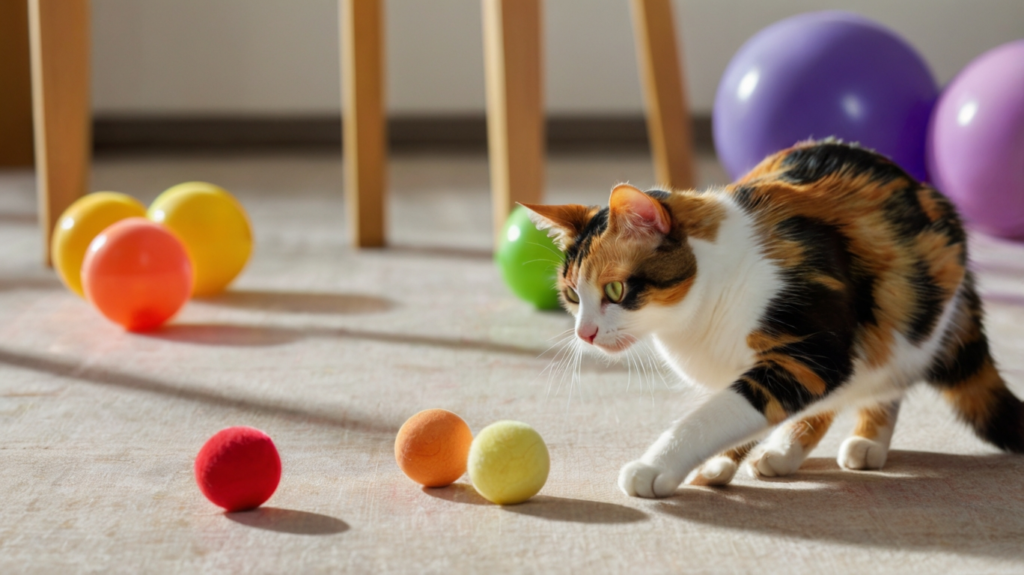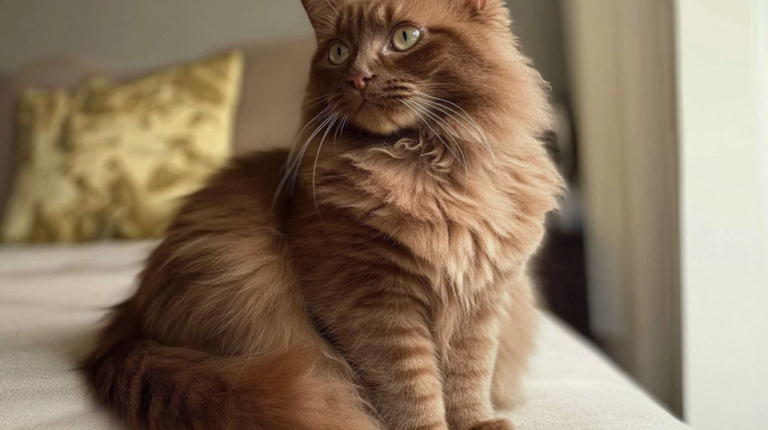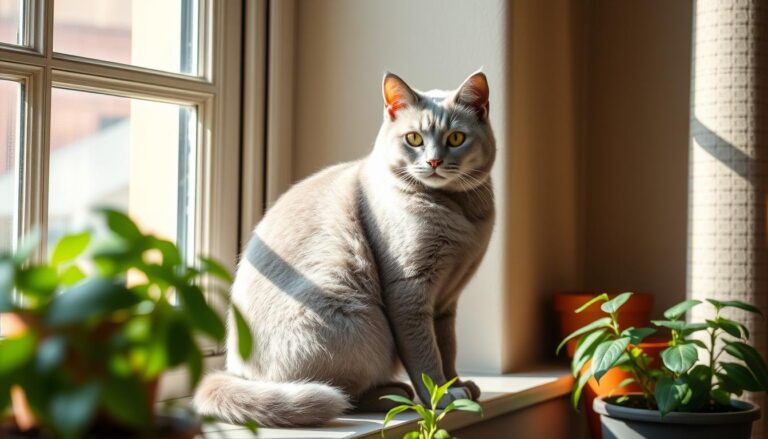Calico Tabby Cat: The Distinctive Companion You’ll Adore
I’ve always loved cats, and the calico tabby cat is special to me. These cats are a rare mix of colors and patterns. Each one is a masterpiece.
Calico tabby cats aren’t a breed but a mix of genetics. Their coats features patches of white, black, and orange. They’re gentle and friendly, makes them fantastic pets.
Here’s a table summarizing the overview of a Calico Tabby Cat:
| Attribute | Details |
|---|---|
| Official Name | Domestic Shorthair/Longhair |
| Common Name | Calico Tabby Cat |
| Pet Height | 8–12 inches (20–30 cm) |
| Pet Weight | 6–16 pounds (2.7–7.3 kg) |
| Lifespan | 12–16 years |
| Smartness Level | High |
| Engagement in Play | Active and Playful |
| Human-Friendly | Very Friendly |
| Animal-Friendly | Moderately Friendly |
| Favorite Food | Chicken, Fish, and Tuna |
Table of Contents
The Captivating World of Calico Cats
Calico cats are known for their stunning tri-color coat patterns. They have a mesmerizing mix of white, black, and orange or tan patches. This look comes from a genetic process called X-inactivation, where one X chromosome is deactivated in each cell.

Exploring the Feline’s Tri-Color Pattern
The calico cat’s tri-color pattern is a marvel of nature. Each cat’s coat is unique, with no two being the same. This makes every calico a one-of-a-kind work of art.
The vibrant colors and striking contrasts are a feast for the eyes. They attract the attention of both dedicated cat lovers and the casually curious.
Origins and Folklore Surrounding Calico Cats
Calico cats have been around for centuries. Their unique look has inspired many cultural beliefs and folklore. In many places, they are seen as good luck charms, believed to bring prosperity and fortune.
Their tri-color coat is also full of symbolism and mythology. It represents harmony, balance, and diversity.
From ancient Egypt to modern Japan, calico cats have a special place in cultures. They are seen as captivating and enchanting feline companions.
Decoding the Genetics of Calico Cats
The calico cat’s tri-color pattern is a result of genetics. The orange and black colors come from genes on the X chromosome. Females, with two X chromosomes, can show both colors, making them calico. Males, with only one X chromosome, can only show one color.
The calico cat’s pattern comes from Lyonization. This is when one X chromosome is turned off in females. This creates the patchwork effect, making the cat’s coat tri-colored.
The calico cat genetics show how complex feline color inheritance is. Knowing about the X chromosome and Lyonization helps us understand their beauty. By exploring cat color genetics, we see the amazing variety in cats.
Traditional Calico: The Classic Tri-Color Beauty
The traditional calico cat is a true beauty, with a mix of white, black, and orange or tan patches. They are often called “tortoiseshell and white” because of their resemblance to tortoiseshell cats. But, they have striking white markings that set them apart. These cats are loved by many, found in various breeds, with the Domestic Shorthair being the most common.

These cats are known for their stunning looks and loving nature. Their coats, a result of special genetics, make them unique. The vibrant orange and black patches against the white areas are truly captivating.
Watching a traditional calico cat in the sun or playing is a joy. Their charming personalities and striking looks have won many hearts. Traditional Calico cats are a favorite among cat lovers everywhere.
Dilute Calico: A Softer Shade of Feline Elegance
There’s a special kind of calico cat that’s a bit more subtle. They’re called dilute calicos. These cats have a softer, more muted look because of the color dilution gene.
When a calico cat gets the dilute gene from both parents, their colors change. The bold black and orange turn into softer blue and cream. This makes dilute calicos look unique and dreamy, adding a special touch to the classic calico look.
Understanding the Dilute Gene
The dilute gene makes the colors in dilute calico cats less intense. It softens the black and orange, turning them into blue and cream. For a kitten to be dilute, both parents must have the recessive dilute gene.
Identifying Dilute Calico Markings
- Dilute calico cats have a tri-color pattern like traditional calicos, but with softer colors.
- Their blue and cream colors are more pastel, making them look delicate and elegant.
- Dilute calico tabbies, with their stripes and patches, are especially striking.
- Long-haired dilute calicos are very fluffy and need regular grooming to keep their coats soft.
Whether you like the bold colors of traditional calicos or the soft charm of dilute calicos, these cats are truly captivating. They are wonderful companions for any household.
| Trait | Traditional Calico | Dilute Calico |
|---|---|---|
| Color Intensity | Vibrant black, orange, and white | Softer blue, cream, and white |
| Rarity | More common | Less common |
| Adoption Cost | $50 to $150 | $500 to $2000 from breeders |
| Hypoallergenic | No | No |
Patched Tabby Calicos: A Unique Fusion
The patched tabby calico is a standout in the world of cat colors. It mixes the classic calico tri-color pattern with the eye-catching tabby markings. This creates a unique look that draws in cat lovers.
The Distinctive Tabby Patterns
The patched tabby calico has the best of both worlds. It has the bright patches of white, black, and orange or tan seen in calicos. It also has the detailed swirls, stripes, and spots of tabbies.
These cats are a treat to look at. Their mix of colors and patterns is truly unique. The tabby markings in the calico patches add even more visual interest. This makes patched tabby calicos a standout among calico cats.
| Cat Color Pattern | Occurrence Rate |
|---|---|
| Patched Tabby Calico | Approximately 10% of the feline population |
| Solid Color Cats | 60-70% of the feline population |
| Bi-Color Cats | 20-30% of the feline population |
| Calico Cats | 5-10% of the feline population |
The mix of calico and tabby patterns in patched tabby calicos comes from genetics. While they’re not super common, they’re highly sought after. They capture the hearts of cat lovers all over the world.
calico tabby cat
The calico tabby cat is a mesmerizing feline. It combines the striking tri-color pattern of the calico with the distinctive markings of the tabby. These cats exhibit a vibrant variety of colors and designs. The classic calico patches of white, black, and orange or tan are complemented by the swirled, striped, or spotted tabby markings.
Calico tabby cats are found in various domestic cat breeds.Every breed is characterized by its individual attributes and temperament. These cats are adored for their stunning and unique feline appearance.
The calico tabby’s cat coat patterns come from the blending of two distinct genetic variations. The calico pattern is caused by the random inactivation of one of the X chromosomes. This results in the unique splotches of color. The tabby markings are the result of a separate genetic trait that produces the swirled, striped, or spotted patterns.
When these two traits come together, the result is a captivating and one-of-a-kind calico tabby cat.
While calico tabby cats are not as common, they are highly sought after. Their distinct charm and personality make them stand out. This makes them a true standout in the world of feline companions.

“The calico tabby cat is a breathtaking example of nature’s artistry, a captivating mix of colors and patterns that always catches the eye.”
Whether you’re drawn to the classic calico patches, the intriguing tabby markings, or the overall enchanting appearance of the calico tabby, these cats are sure to leave a lasting impression. So, if you’re in the market for a feline friend with a truly unique and eye-catching cat coat patterns, the calico tabby might just be the perfect addition to your family.
The Rarity of Male Calicos
Calico cats are mostly female, but male calicos are rare. It’s estimated that just 1 in 3,000 calico cats is male. This rarity comes from a genetic anomaly called Klinefelter syndrome, where they have an extra X chromosome (XXY).
This condition lets them show both orange and black colors, creating the calico pattern. However, these male calicos are usually sterile and may have health problems. That’s why they’re not common in cat shows.
Genetic Anomalies and Klinefelter Syndrome
Klinefelter syndrome affects male cats, giving them an extra X chromosome. This genetic issue can cause a calico coat pattern. The extra X chromosome lets them show both orange and black colors.
Unfortunately, male calico cats with Klinefelter syndrome often have health issues. They might have cognitive problems, less bone density, and a higher risk of obesity. They’re also usually sterile, making them very rare.
Despite their rarity and health challenges, male calico cats have won many hearts. Their unique look and interesting genetic story make them a favorite among cat lovers and scientists.
Calico Coat Variations: Shorthair and Longhair
Calico cats are known for their stunning tricolor fur. They can have either shorthair or longhair coats, depending on the breed. Most calico cats are Domestic Shorthairs, but other breeds like Maine Coons, Persians, and Norwegian Forest Cats also display this pattern.
Longhair calico cats have soft, fluffy coats. They often look more dramatic than shorthair calicos. Both types are valued for their bright and unique color patterns. These can range from classic tri-colors to softer, diluted designs.
| Coat Type | Calico Cat Breeds | Coat Characteristics |
|---|---|---|
| Shorthair |
|
|
| Longhair |
|
|
Calico cats, no matter their coat type, are loved for their striking looks. They are remarkable figures in the world of cats.
Conclusion
Calico tabby cats are a special mix of colors and patterns. They have the tri-color look of calicos and the unique tabby markings. These cats come in different looks, like the classic tri-color and the softer dilute calico.
Male calico cats are very rare, but we know how they get their colors. This makes them even more interesting.
Calico cats are loved for their beautiful looks and loving nature. They are so special that Maryland made them the official state cat. If you see a calico tabby or have one at home, you’ll see why they’re so loved.
Calico cats are loved by many in the United States. They come in many breeds and looks, each with its own charm. Exploring the world of calico cats will show you their beauty and the happiness they bring to their owners.







